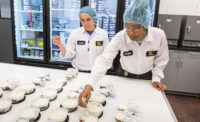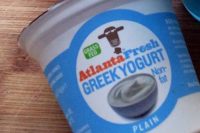The processing of many dairy-based products begins with raw milk. A supply of good, clean safe milk is the starting point for quality dairy foods and beverages. After that, superior processing techniques, packaging and storage (not to mention high-quality sanitation standards) are required to turn good milk into good products.
In this article, suppliers of laboratory equipment share their ideas about what it takes to build a quality on-site dairy lab, and the tests that dairy processors need to perform on raw milk and on work in progress.
Dairy Foods: At minimum, what equipment does a dairy processor need for an on-site lab?
Keller Barnhardt, CEM Corp.: Every lab, regardless of size or production output, should be equipped to test two major portions of their product. First, they need the ability to perform basic micro-chemistry tests for pathogens and adulterants, since nothing is more disruptive to a company than having to perform a recall because product was released before results were returned.
Equally as important to running a successful production facility is the ability to test the basic process control parameters, moisture, fat and protein. Without the ability to quickly and accurately provide results to production technicians, formulations, yield and profit can be drastically affected and cost companies huge sums of profit.
Dairy Foods: What are the basic tests that dairies should perform on raw milk, and what can the results tell them?
Wendy Rogalinski, Charm Sciences: Prior to receiving milk, several tests are standard, including APPN antibiotic tests for Beta-lactams, and direct microscopic count (DMC) for bacteria morphology, which can indicate the cause of high somatic micro counts.
Butterfat is tested on a cryoscope for added water, and the smell test checks for off odors. Additional optional tests include the somatic cell test for mastitis, and centrifuge milk test for the level of blood.
Not many dairies continue to perform titratable acidity tests on incoming milk, as they test for other drugs. There are also standard plate count (SPC) procedures to determine bacteria such as coliform growing during preliminary incubation (PI).
Dairy Foods: What are the basic tests a dairy should be performing on work in progress and on finished products?
Jo Smewing, Stable Micro Systems: Quantifiable texture analysis of dairy foods is an evolving area of quality assurance that is yet to reach its full potential. Such a measure, employed across a range of dairy products can provide manufacturers with the peace of mind that their dairy offering consistently meets consumer expectations, while also helping to guide their research and development and optimize their production and packaging processes.
Analyzing the texture of unsupported structures such as yogurt, crème fraiche, whipped, sour and clotted creams and mousses is important, as it can provide manufacturers with vital information as to a product’s consistency throughout its shelf life, which can vary drastically as the active ingredients begin to ferment. Finding a yogurt with an unappealing pool of water on the surface, for example, is not uncommon.
In addition, [testing for texture] offers a valuable comparison between different products hoping to achieve the same consistency; for example, full-fat and reduced-fat mayonnaise. It is notoriously difficult to quantify such structures because they flow if unsupported, poured, pumped, extruded or spread during handling or consumption. A measurement of their consistency can be achieved if they are analyzed in a vessel or container.
For viscous solids such as butter, margarine, dairy spreads and other processed cheeses, their uniform structure is self-supporting at low temperatures; melting as the temperature rises and during handling. It is useful for manufacturers to explore the ease with which their products can be spread and applied at a number of temperatures, in order to optimize formulations and ensure that they offer consumers preferable functionality.
A simple wire cutting test will demonstrate the firmness and consistency of a cheese, and can also be used for butter and block ice creams.
Barnhardt: Process control is the most important to in-process product, because only by catching bad formulations or out-of-spec product early can batches of product be salvaged. Sending out for results or having on-site equipment give inaccurate data will only decrease the yield and quality of processed dairy products.
George Hutson, ProSpect Analytical Technology: Dairy producers can optimize the accuracy of achieving their formula targets and boost yield and product quality by adding in-line near infrared (NIR) analysis to their production processes. This can be accomplished at any stage — from incoming raw material through work in progress to the finished product for a variety of applications including butter, cheese milk, yogurt, WPC, MPC and many more.
Working in tandem with traditional laboratory testing, in-line NIR analysis delivers the added advantage of supplying production data in real time. By measuring light energy as it is transmitted through or reflected by product flowing through the pipe as it is being processed, high resolution NIR spectrometers make accurate real-time predictions of protein, moisture, fat, solids and other constituents.
In-line NIR analyzers communicate this real time information to the factory PLC, enabling continuous adjustments to process set points during production. Customers who implement in-line NIR analysis are able to control their production to tighter variances and average a 50% reduction in their standard deviation.
Dairy Foods: Talk about the database and record-keeping aspects of your equipment.
Jackie Page, Page & Pedersen International: [Our company’s] data recording and reporting software system automatically records a complete milk composition profile as generated by the milk composition analyzer. Results can be transferred via a comma separated file in an ASCII format to most standard spreadsheet programs for further reporting. Date, product information and supplier (or animal number/group) can be recorded. Customization is available to meet specific requirements.
[Software for cheese making] provides more in-depth database capabilities for use in taking control and keeping control of the cheese-making process. Seven separate but integrated databases
record a broad base of intrinsic information including ingredients (by batch and expiration date), make-sheets (or production sheets) with details regarding time from the fill of the vat to when each specific step must be completed
and financial insight comparing predicted yield to actual yield together with costs and profits by batch.
Outfitting a dairy lab
An onsite dairy lab needs a variety of equipment. For a quality control lab, consider the following:
- autoclave
- fume hood
- incubator
- refrigerator
- freezer
- hot plate
- water bath
- titration set up
- pH meter
- pipettors
- thermometers
- vacuum oven
- centrifuge
- stomacher/masticator
- scale
- colony counter/reader
- microscope
- luminometer
A quality control lab that performs higher-volume testing will typically invest in rapid method testing equipment such as an FTIR autodigestor and/or titrator for time-efficient chemical composition testing. It also may have equipment that minimizes test/incubation time and/or amount of media needed for microbiological analysis, such as using rapid method PCR, ELISA and flow cytometry.
A cultured dairy products manufacturing lab may also have a mixer used for sample preparation, an activity test set up and a Zahn cup or viscometer to test viscosity of the product.
A dairy’s receiving lab must also contain additional equipment to ensure incoming raw milk is unadulterated by testing for antibiotics and added water using a cryoscope.
Source: Charm Sciences, Inc., Lawrence, Mass.
Testing, testing
An on-site milk receiving lab needs to perform the following tests:
- Appendix N, antibiotic tests for beta-lactams. Manufacturers of cultured dairy products might also want to perform residue testing for other inhibitors that may interfere with the growth of bacterial cultures in the finished product.
- Standard Plating Method, aerobic and coliform detection to determine the quality of raw milk
- Cryoscope test, to confirm raw milk was not adulterated with added water
- Somatic cell, to assess quality of incoming milk
- Milk temperature. Check that its meets Pasteurized Milk Ordinance milk temperature regulations for keeping quality
- Tanker system. Check that the wash tag is within 72 hours to ensure cleanliness
- Direct microscopic somatic cell count (DMSCC). This test determines the quality of raw milk.
- Titratable acidity. This will determine the lactic acid percentage in raw milk. It is also an indicator of the quality of raw milk. Perform this test on milk for fluid products, ice creams, cultured products and dry products.
- Some dairies perform Preliminary Incubation (PI Count) where the milk is incubated and plated. If spikes occur, then further investigation is needed to determine the source of microbial contamination. Contamination could impact the shelf life of the product.
- The following tests are important during processing and for finished product:
- Microbiological count, traditional methods. (Alternatively, a plate loop method or an approved film method is sometimes used). Can be used for all dairy products.
- Pasteurization efficiency testing. Determines if a dairy product is fully pasteurized. This is the most critical safety part of a Hazard Analysis Critical Control Point (HACCP) plan. Can be used with milks, cheese, ice cream and cultured products.
- Butterfat analysis. For product standardization and producer payment.
Sources: Weber Scientific, Hamilton, N.J., and Charm Sciences, Lawrence, Mass.



